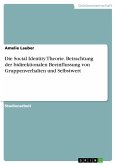Carlotta Giustozzi
Social Consequences of Labour Market Marginalisation in Germany
Analysing the Impact of Social Identities and Values
Carlotta Giustozzi
Social Consequences of Labour Market Marginalisation in Germany
Analysing the Impact of Social Identities and Values
- Broschiertes Buch
- Merkliste
- Auf die Merkliste
- Bewerten Bewerten
- Teilen
- Produkt teilen
- Produkterinnerung
- Produkterinnerung
Das Buch untersucht die sozialen Folgen von Arbeitsmarktmarginaliserung für nahe soziale Beziehungen und gesellschaftliche Partizipation in Deutschland. Dabei zeigen Mehrebenenmodelle und Längsschnittanalysen, die individuelle, haushaltsbezogene und regionale sozio-ökonomische Faktoren analysieren, dass finanzielle Schwierigkeiten nur marginal soziale Exklusion erklären können. Vielmehr sind soziale Rollen, Normen und Identität ausschlaggebend für eine Arbeitsmarktmarginalisierung.
Andere Kunden interessierten sich auch für
![Das bisschen Haushalt Das bisschen Haushalt]() Ruth AbramowskiDas bisschen Haushalt77,00 €
Ruth AbramowskiDas bisschen Haushalt77,00 €![Zeitdruck, Anpassung und Konkurrenz: Eine Fotobefragung zum beruflichen Habitus von Juniorprofessorinnen und Juniorprofessoren Zeitdruck, Anpassung und Konkurrenz: Eine Fotobefragung zum beruflichen Habitus von Juniorprofessorinnen und Juniorprofessoren]() Lara AltenstädterZeitdruck, Anpassung und Konkurrenz: Eine Fotobefragung zum beruflichen Habitus von Juniorprofessorinnen und Juniorprofessoren62,00 €
Lara AltenstädterZeitdruck, Anpassung und Konkurrenz: Eine Fotobefragung zum beruflichen Habitus von Juniorprofessorinnen und Juniorprofessoren62,00 €![Einführung in die Mehrebenenanalyse Einführung in die Mehrebenenanalyse]() Uwe EngelEinführung in die Mehrebenenanalyse44,99 €
Uwe EngelEinführung in die Mehrebenenanalyse44,99 €![Die Social Identity Theorie. Betrachtung der bidirektionalen Beeinflussung von Gruppenverhalten und Selbstwert Die Social Identity Theorie. Betrachtung der bidirektionalen Beeinflussung von Gruppenverhalten und Selbstwert]() Amelie LauberDie Social Identity Theorie. Betrachtung der bidirektionalen Beeinflussung von Gruppenverhalten und Selbstwert17,95 €
Amelie LauberDie Social Identity Theorie. Betrachtung der bidirektionalen Beeinflussung von Gruppenverhalten und Selbstwert17,95 €![Hopes and Anxieties in Europe Hopes and Anxieties in Europe]() Hopes and Anxieties in Europe60,85 €
Hopes and Anxieties in Europe60,85 €![Teilzeitarbeit im Lebensverlauf von Männern Teilzeitarbeit im Lebensverlauf von Männern]() Agnieszka AlthaberTeilzeitarbeit im Lebensverlauf von Männern64,00 €
Agnieszka AlthaberTeilzeitarbeit im Lebensverlauf von Männern64,00 €![Causality and Causal Modelling in the Social Sciences Causality and Causal Modelling in the Social Sciences]() Federica RussoCausality and Causal Modelling in the Social Sciences113,99 €
Federica RussoCausality and Causal Modelling in the Social Sciences113,99 €-
-
-
Das Buch untersucht die sozialen Folgen von Arbeitsmarktmarginaliserung für nahe soziale Beziehungen und gesellschaftliche Partizipation in Deutschland. Dabei zeigen Mehrebenenmodelle und Längsschnittanalysen, die individuelle, haushaltsbezogene und regionale sozio-ökonomische Faktoren analysieren, dass finanzielle Schwierigkeiten nur marginal soziale Exklusion erklären können. Vielmehr sind soziale Rollen, Normen und Identität ausschlaggebend für eine Arbeitsmarktmarginalisierung.
Produktdetails
- Produktdetails
- Schriften der Willy Brandt School of Public Policy an der Universität Erfurt
- Verlag: Budrich Academic Press / Verlag Barbara Budrich
- Artikelnr. des Verlages: 12148
- Seitenzahl: 268
- Erscheinungstermin: 11. Juli 2022
- Englisch
- Abmessung: 207mm x 146mm x 16mm
- Gewicht: 345g
- ISBN-13: 9783966650557
- ISBN-10: 396665055X
- Artikelnr.: 63751905
- Herstellerkennzeichnung
- Budrich Academic Press GmbH
- Stauffenbergstr. 7
- 51379 Leverkusen
- buch@budrich-unipress.de
- www.budrich-verlag.de
- +49 (02171) 7949150
- Schriften der Willy Brandt School of Public Policy an der Universität Erfurt
- Verlag: Budrich Academic Press / Verlag Barbara Budrich
- Artikelnr. des Verlages: 12148
- Seitenzahl: 268
- Erscheinungstermin: 11. Juli 2022
- Englisch
- Abmessung: 207mm x 146mm x 16mm
- Gewicht: 345g
- ISBN-13: 9783966650557
- ISBN-10: 396665055X
- Artikelnr.: 63751905
- Herstellerkennzeichnung
- Budrich Academic Press GmbH
- Stauffenbergstr. 7
- 51379 Leverkusen
- buch@budrich-unipress.de
- www.budrich-verlag.de
- +49 (02171) 7949150
Carlotta Giustozzi, postdoctoral researcher, institute of sociology at Goethe University Frankfurt/Main, Germany.
1. Introduction - The Relationship of Labour Market Marginalisation and Social Exclusion
1.1 Scientific Evidence and Main Expectations about the Effects of Labour Market Marginalisation on Social Integration
1.2 Conceptual Framework and Analytical Approach
1.3 The Setup of the Empirical Analysis
1.4 Three Dimensions of the Labour Market and Social Exclusion Relationship
1.5 Overview of the Thesis
2 Conceptualising Labour Market Marginalisation and Social Integration
2.1 Determinants of Social Exclusion
2.1.1 Multidimensionality of Social Exclusion
2.1.2 Two Spheres of Sociability
2.2 Making Sense of the Multi-Layered Functions of Employment
2.2.1 Materialist Perspectives on Labour Market Disadvantage
2.2.2 Social Identity Perspectives on Labour Market Disadvantage
2.2.3 The Context's Influence on Individual Labour Market Experiences
2.2.4 Interrelation of Financial Distress and Identity Struggles
2.3 Dynamics of Labour Market Marginalisation
2.3.1 The Cumulative Tendency of Disadvantage
2.3.2 Social Class, Vulnerability, and the Distribution of Labour Market Risks
2.4 Summary
3 Data and Methods
3.1 A Combined Longitudinal and Multi-level Data Set
3.2 Sample
3.3 Data Challenges - Non-response and Missing Values
3.4 Operationalisation of Core Concepts
3.4.1 Explaining the Labour Market Marginalisation and Social Exclusion Link
3.4.2 Contextualising Individual Labour Market Experiences
3.5 Methodological Considerations - Modelling Longitudinal and Hierarchical Data
4 Accumulation of Labour Market Disadvantage - Individual, Household, and Regional Factors
4.1 Path Dependency - The Cumulative Process of Disadvantage
4.1.1 Explaining Cumulative Tendencies of Disadvantage - the Impact of Resources and Social Roles
4.1.2 Gender, Partnership and Household Composition - How Social Roles Reinforce Labour Market Positions and Trajectories
4.1.3 Context Factors - the Impact of Regional Labour Markets, Wealth, Demography, and Institutional Settings
4.2 Analytical Strategy and Operationalization
4.3 The Impact of Employment Histories, Favourable and Harmful Contexts
4.3.1 Accumulation of (Dis-) Advantage - the Intensification of Effects
4.3.2 Social Roles Determine Female Vulnerability to Labour Market Marginalisation
4.3.3 Regional Labour Markets, Fertility Rates, and Childcare Availability Have a Greater Impact on Female than Male Labour Market Outcomes
4.4 Concluding Remarks on the Accumulation of Labour Market Marginalisation
4.5 Appendix
5 Labour Market Marginalisation and Social Embeddedness: Unravelling the Conditions for Deteriorating Personal Relations
5.1 Taking Multidimensional Linkages of Labour Market Disadvantage and Social Relations into Account
5.1.1 Gendered Effects of Labour Market Marginalisation
5.1.2 Age Dependent Vulnerability to Negative Labour Market Experiences
5.1.3 Linked Lives - Labour Market Marginalisation in the Household Context
5.1.4 Assessing the Spatial Dimension of Individual Labour Market Experiences
5.1.5 Summary
5.2 Analytical Strategy and Operationalization
5.3 Exploring the Four Social-Structural Dimensions of Inequality
5.3.1 Gendered Patterns of Labour Market Disadvantage
5.3.2 Labour Market Disadvantage at Different Life Stages
5.3.3 The Unexpected Weak Effect of Household Composition for Labour MarketDisadvantage
5.3.4 Contextualizing Individual Labour Market Experiences - Assessing the Impact of Regional Labour M
1.1 Scientific Evidence and Main Expectations about the Effects of Labour Market Marginalisation on Social Integration
1.2 Conceptual Framework and Analytical Approach
1.3 The Setup of the Empirical Analysis
1.4 Three Dimensions of the Labour Market and Social Exclusion Relationship
1.5 Overview of the Thesis
2 Conceptualising Labour Market Marginalisation and Social Integration
2.1 Determinants of Social Exclusion
2.1.1 Multidimensionality of Social Exclusion
2.1.2 Two Spheres of Sociability
2.2 Making Sense of the Multi-Layered Functions of Employment
2.2.1 Materialist Perspectives on Labour Market Disadvantage
2.2.2 Social Identity Perspectives on Labour Market Disadvantage
2.2.3 The Context's Influence on Individual Labour Market Experiences
2.2.4 Interrelation of Financial Distress and Identity Struggles
2.3 Dynamics of Labour Market Marginalisation
2.3.1 The Cumulative Tendency of Disadvantage
2.3.2 Social Class, Vulnerability, and the Distribution of Labour Market Risks
2.4 Summary
3 Data and Methods
3.1 A Combined Longitudinal and Multi-level Data Set
3.2 Sample
3.3 Data Challenges - Non-response and Missing Values
3.4 Operationalisation of Core Concepts
3.4.1 Explaining the Labour Market Marginalisation and Social Exclusion Link
3.4.2 Contextualising Individual Labour Market Experiences
3.5 Methodological Considerations - Modelling Longitudinal and Hierarchical Data
4 Accumulation of Labour Market Disadvantage - Individual, Household, and Regional Factors
4.1 Path Dependency - The Cumulative Process of Disadvantage
4.1.1 Explaining Cumulative Tendencies of Disadvantage - the Impact of Resources and Social Roles
4.1.2 Gender, Partnership and Household Composition - How Social Roles Reinforce Labour Market Positions and Trajectories
4.1.3 Context Factors - the Impact of Regional Labour Markets, Wealth, Demography, and Institutional Settings
4.2 Analytical Strategy and Operationalization
4.3 The Impact of Employment Histories, Favourable and Harmful Contexts
4.3.1 Accumulation of (Dis-) Advantage - the Intensification of Effects
4.3.2 Social Roles Determine Female Vulnerability to Labour Market Marginalisation
4.3.3 Regional Labour Markets, Fertility Rates, and Childcare Availability Have a Greater Impact on Female than Male Labour Market Outcomes
4.4 Concluding Remarks on the Accumulation of Labour Market Marginalisation
4.5 Appendix
5 Labour Market Marginalisation and Social Embeddedness: Unravelling the Conditions for Deteriorating Personal Relations
5.1 Taking Multidimensional Linkages of Labour Market Disadvantage and Social Relations into Account
5.1.1 Gendered Effects of Labour Market Marginalisation
5.1.2 Age Dependent Vulnerability to Negative Labour Market Experiences
5.1.3 Linked Lives - Labour Market Marginalisation in the Household Context
5.1.4 Assessing the Spatial Dimension of Individual Labour Market Experiences
5.1.5 Summary
5.2 Analytical Strategy and Operationalization
5.3 Exploring the Four Social-Structural Dimensions of Inequality
5.3.1 Gendered Patterns of Labour Market Disadvantage
5.3.2 Labour Market Disadvantage at Different Life Stages
5.3.3 The Unexpected Weak Effect of Household Composition for Labour MarketDisadvantage
5.3.4 Contextualizing Individual Labour Market Experiences - Assessing the Impact of Regional Labour M
1. Introduction - The Relationship of Labour Market Marginalisation and Social Exclusion
1.1 Scientific Evidence and Main Expectations about the Effects of Labour Market Marginalisation on Social Integration
1.2 Conceptual Framework and Analytical Approach
1.3 The Setup of the Empirical Analysis
1.4 Three Dimensions of the Labour Market and Social Exclusion Relationship
1.5 Overview of the Thesis
2 Conceptualising Labour Market Marginalisation and Social Integration
2.1 Determinants of Social Exclusion
2.1.1 Multidimensionality of Social Exclusion
2.1.2 Two Spheres of Sociability
2.2 Making Sense of the Multi-Layered Functions of Employment
2.2.1 Materialist Perspectives on Labour Market Disadvantage
2.2.2 Social Identity Perspectives on Labour Market Disadvantage
2.2.3 The Context's Influence on Individual Labour Market Experiences
2.2.4 Interrelation of Financial Distress and Identity Struggles
2.3 Dynamics of Labour Market Marginalisation
2.3.1 The Cumulative Tendency of Disadvantage
2.3.2 Social Class, Vulnerability, and the Distribution of Labour Market Risks
2.4 Summary
3 Data and Methods
3.1 A Combined Longitudinal and Multi-level Data Set
3.2 Sample
3.3 Data Challenges - Non-response and Missing Values
3.4 Operationalisation of Core Concepts
3.4.1 Explaining the Labour Market Marginalisation and Social Exclusion Link
3.4.2 Contextualising Individual Labour Market Experiences
3.5 Methodological Considerations - Modelling Longitudinal and Hierarchical Data
4 Accumulation of Labour Market Disadvantage - Individual, Household, and Regional Factors
4.1 Path Dependency - The Cumulative Process of Disadvantage
4.1.1 Explaining Cumulative Tendencies of Disadvantage - the Impact of Resources and Social Roles
4.1.2 Gender, Partnership and Household Composition - How Social Roles Reinforce Labour Market Positions and Trajectories
4.1.3 Context Factors - the Impact of Regional Labour Markets, Wealth, Demography, and Institutional Settings
4.2 Analytical Strategy and Operationalization
4.3 The Impact of Employment Histories, Favourable and Harmful Contexts
4.3.1 Accumulation of (Dis-) Advantage - the Intensification of Effects
4.3.2 Social Roles Determine Female Vulnerability to Labour Market Marginalisation
4.3.3 Regional Labour Markets, Fertility Rates, and Childcare Availability Have a Greater Impact on Female than Male Labour Market Outcomes
4.4 Concluding Remarks on the Accumulation of Labour Market Marginalisation
4.5 Appendix
5 Labour Market Marginalisation and Social Embeddedness: Unravelling the Conditions for Deteriorating Personal Relations
5.1 Taking Multidimensional Linkages of Labour Market Disadvantage and Social Relations into Account
5.1.1 Gendered Effects of Labour Market Marginalisation
5.1.2 Age Dependent Vulnerability to Negative Labour Market Experiences
5.1.3 Linked Lives - Labour Market Marginalisation in the Household Context
5.1.4 Assessing the Spatial Dimension of Individual Labour Market Experiences
5.1.5 Summary
5.2 Analytical Strategy and Operationalization
5.3 Exploring the Four Social-Structural Dimensions of Inequality
5.3.1 Gendered Patterns of Labour Market Disadvantage
5.3.2 Labour Market Disadvantage at Different Life Stages
5.3.3 The Unexpected Weak Effect of Household Composition for Labour MarketDisadvantage
5.3.4 Contextualizing Individual Labour Market Experiences - Assessing the Impact of Regional Labour M
1.1 Scientific Evidence and Main Expectations about the Effects of Labour Market Marginalisation on Social Integration
1.2 Conceptual Framework and Analytical Approach
1.3 The Setup of the Empirical Analysis
1.4 Three Dimensions of the Labour Market and Social Exclusion Relationship
1.5 Overview of the Thesis
2 Conceptualising Labour Market Marginalisation and Social Integration
2.1 Determinants of Social Exclusion
2.1.1 Multidimensionality of Social Exclusion
2.1.2 Two Spheres of Sociability
2.2 Making Sense of the Multi-Layered Functions of Employment
2.2.1 Materialist Perspectives on Labour Market Disadvantage
2.2.2 Social Identity Perspectives on Labour Market Disadvantage
2.2.3 The Context's Influence on Individual Labour Market Experiences
2.2.4 Interrelation of Financial Distress and Identity Struggles
2.3 Dynamics of Labour Market Marginalisation
2.3.1 The Cumulative Tendency of Disadvantage
2.3.2 Social Class, Vulnerability, and the Distribution of Labour Market Risks
2.4 Summary
3 Data and Methods
3.1 A Combined Longitudinal and Multi-level Data Set
3.2 Sample
3.3 Data Challenges - Non-response and Missing Values
3.4 Operationalisation of Core Concepts
3.4.1 Explaining the Labour Market Marginalisation and Social Exclusion Link
3.4.2 Contextualising Individual Labour Market Experiences
3.5 Methodological Considerations - Modelling Longitudinal and Hierarchical Data
4 Accumulation of Labour Market Disadvantage - Individual, Household, and Regional Factors
4.1 Path Dependency - The Cumulative Process of Disadvantage
4.1.1 Explaining Cumulative Tendencies of Disadvantage - the Impact of Resources and Social Roles
4.1.2 Gender, Partnership and Household Composition - How Social Roles Reinforce Labour Market Positions and Trajectories
4.1.3 Context Factors - the Impact of Regional Labour Markets, Wealth, Demography, and Institutional Settings
4.2 Analytical Strategy and Operationalization
4.3 The Impact of Employment Histories, Favourable and Harmful Contexts
4.3.1 Accumulation of (Dis-) Advantage - the Intensification of Effects
4.3.2 Social Roles Determine Female Vulnerability to Labour Market Marginalisation
4.3.3 Regional Labour Markets, Fertility Rates, and Childcare Availability Have a Greater Impact on Female than Male Labour Market Outcomes
4.4 Concluding Remarks on the Accumulation of Labour Market Marginalisation
4.5 Appendix
5 Labour Market Marginalisation and Social Embeddedness: Unravelling the Conditions for Deteriorating Personal Relations
5.1 Taking Multidimensional Linkages of Labour Market Disadvantage and Social Relations into Account
5.1.1 Gendered Effects of Labour Market Marginalisation
5.1.2 Age Dependent Vulnerability to Negative Labour Market Experiences
5.1.3 Linked Lives - Labour Market Marginalisation in the Household Context
5.1.4 Assessing the Spatial Dimension of Individual Labour Market Experiences
5.1.5 Summary
5.2 Analytical Strategy and Operationalization
5.3 Exploring the Four Social-Structural Dimensions of Inequality
5.3.1 Gendered Patterns of Labour Market Disadvantage
5.3.2 Labour Market Disadvantage at Different Life Stages
5.3.3 The Unexpected Weak Effect of Household Composition for Labour MarketDisadvantage
5.3.4 Contextualizing Individual Labour Market Experiences - Assessing the Impact of Regional Labour M








